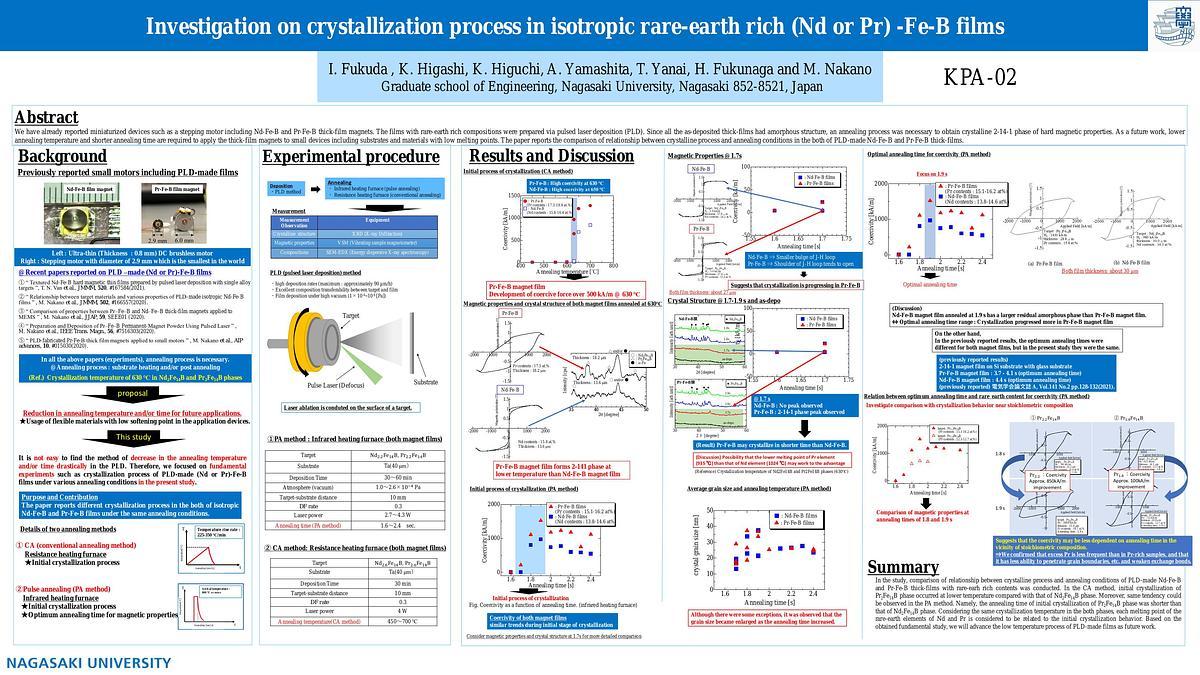
Premium content
Access to this content requires a subscription. You must be a premium user to view this content.

poster
Investigation on crystallization process in isotropic rare earth rich (Nd or Pr)
A lot of researchers have reported anisotropic (Nd or Pr) -Fe-B films prepared by a sputtering method 1. In the experiment, the condition of annealing processes has been deeply investigated for obtaining excellent magnetic properties. We have demonstrated a miniaturized motor including PLD (Pulsed Laser Deposition)-fabricated isotropic (Nd or Pr) -Fe-B films with rare-earth rich composition compared to stoichiometric one 2. Due to amorphous structure after the laser deposition, post-annealing is required to form the 2-14-1 phase to obtain isotropic hard magnetic films. Although a detailed investigation on the crystallization process is required to enhance isotropic magnetic properties, unfortunately there are not many reports on isotropic (Nd or Pr)-Fe-B films. In the study, we focused on the different phenomena through a post-annealing between isotropic rare-earth rich Nd-Fe-B and Pr-Fe-B films.
Figure 1 shows coercivity of (Nd or Pr)-Fe-B films with rare earth content of 15.5 - 18.5 at. % as a function of annealing temperature in a resistance heating furnace. While the coercivity value of Nd-Fe-B films did not change up to 650 °C, the value of Pr-Fe-B films enhanced between 600 and 650 °C. Moreover, figure 2 shows the results of pulse (flash) annealing using an infrared furnace after the deposition of rare earth-rich (Nd or Pr)-Fe-B films. Although two films were annealed at the same annealing time of 1.7 s, the shoulder of a J-H loop (dotted line) for only a Pr-Fe-B film was open. X-ray diffraction patterns indicate that the 2-14-1 phase formed in the Pr-Fe-B film. In contrast, we observed that the Nd-Fe-B film had amorphous structure. Assuming that the crystallization temperatures of Pr2Fe14B and Nd2Fe14B phases are the same, the phenomenon is due to the difference in diffusion transfer of each rare earth atom during the annealing process. We consider the correlation between the diffusion transfer and the melting points (Nd: 1024 °C, Pr: 930 °C) of each element.
References:
1 N. M. Dempsey et.al., Appl. Phys. Lett. Vol. A90, 092509(2007).
2 M. Nakano et.al., IEEE Trans. Magn. Vol. 56, 7516303(2020).

Fig. 1 Coercivity values of isotropic Pr-Fe-B and Nd-Fe-B films as a function of annealing temperature. (resistance heating furnace)

Fig. 2 J-H loops of Pr-Fe-B(dotted line) and Nd-Fe-B(solid line) films annealed at 1.7 s. (infrared furnace)

